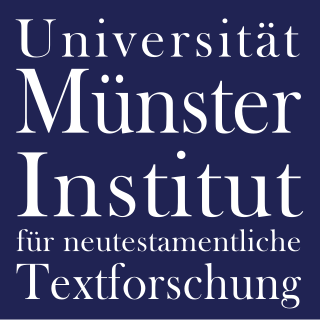History
Scrivener dated the manuscript to the 11th century, Gregory dated it to the 12th century. [3] [4] It has been assigned by the Institute for New Testament Textual Research to the 12th century. [1] [2]

The Institute for New Testament Textual Research at the University of Münster, Westphalia, Germany, is to research the textual history of the New Testament and to reconstruct its Greek initial text on the basis of the entire manuscript tradition, the early translations and patristic citations; furthermore the preparation of an Editio Critica Maior based on the entire tradition of the New Testament in Greek manuscripts, early versions and New Testament quotations in ancient Christian literature. Under Kurt Aland's supervision, the INTF collected almost the entire material that was needed - Manuscript count 1950: 4250; 1983: 5460; 2017: approx. 5800.
The manuscript was brought from Mount Athos in 1727. It was examined by Mangey. [4]

Mount Athos is a mountain and peninsula in northeastern Greece and an important centre of Eastern Orthodox monasticism. It is governed as an autonomous polity within the Greek Republic. Mount Athos is home to 20 monasteries under the direct jurisdiction of the Ecumenical Patriarch of Constantinople.
The manuscript was added to the list of New Testament manuscripts by Scrivener (number 210) and Gregory (number 202). Gregory saw it in 1883. [4]
The manuscript is not cited in the critical editions of the Greek New Testament (UBS3). [5]
The codex is located in the Bodleian Library (Cromw. 27) in Oxford. [1] [2]
Lectionary 191, designated by siglum ℓ 191 is a Greek manuscript of the New Testament, on parchment leaves. Palaeographically it has been assigned to the 12th century.
Scrivener labelled it by 263evl.
Lectionary 198, designated by siglum ℓ 198 is a Greek manuscript of the New Testament, on parchment. Palaeographically it has been assigned to the 12th century. The manuscript has complex contents.
Scrivener labelled it by 206evl.
Lectionary 199, designated by siglum ℓ 199 is a Greek manuscript of the New Testament, on parchment. Palaeographically it has been assigned to the 13th century.
Scrivener labelled it by 207evl.
Lectionary 200, designated by siglum ℓ 200 is a Greek parchment manuscript of the New Testament. Palaeographically it has been assigned to the 12th century.
Scrivener labelled it by 208evl.
Lectionary 201, designated by siglum ℓ 201 is a Greek manuscript of the New Testament, on parchment. Palaeographically it has been assigned to the 13th century.
Scrivener labelled it by 209evl.
Lectionary 204, designated by siglum ℓ 204 is a Greek manuscript of the New Testament, on parchment. Palaeographically it has been assigned to the 11th century.
Scrivener labelled it by 212evl.
The manuscript has complex context.

Lectionary 205, designated by siglum ℓ 205 is a Greek manuscript of the New Testament, on parchment. Palaeographically it has been assigned to the 10th century.
Scrivener labelled it by 201evl.
The manuscript has complex context.
Lectionary 206, designated by siglum ℓ 206 is a Greek manuscript of the New Testament, on parchment. Palaeographically it has been assigned to the 11th century.
Scrivener labelled it by 213evl.
The manuscript is lacunose.
Lectionary 207, designated by siglum ℓ 207 is a Greek manuscript of the New Testament, on parchment. Palaeographically it has been assigned to the 12th century.
Scrivener labelled it by 214evl.
The manuscript has complex context.
Lectionary 209, designated by siglum ℓ 209 is a Greek manuscript of the New Testament, on parchment. Palaeographically it has been assigned to the 12th century.
Scrivener labelled it by 216evl.
The manuscript is lacunose.
Lectionary 210, designated by siglum ℓ 210 is a Greek manuscript of the New Testament, on parchment. Palaeographically it has been assigned to the 12th century.
Scrivener labelled it by 217evl.
The manuscript is lacunose.
Lectionary 212, designated by siglum ℓ 212 is a Greek manuscript of the New Testament, on parchment. Palaeographically it has been assigned to the 11th century.
Scrivener labelled it by 219evl.
The manuscript is lacunose.
Lectionary 213, designated by siglum ℓ 213, is a Greek manuscript of the New Testament, on parchment. Palaeographically it has been assigned to the 13th century.
Scrivener labelled it by 220evl.
The manuscript has complex context.
Lectionary 229, designated by siglum ℓ 229 is a Greek manuscript of the New Testament, on parchment. Palaeographically it has been assigned to the 13th century.
Scrivener labelled it by 223evl.
The manuscript has complex context.
Lectionary 233, designated by siglum ℓ 233 is a Greek manuscript of the New Testament, on parchment. Palaeographically it has been assigned to the 11th century. Scrivener labelled it by 235evl.
Some leaves of the codex were lost.
Lectionary 263, designated by siglum ℓ 263, is a Greek manuscript of the New Testament, on parchment. Palaeographically it has been assigned to the 12th century.
Scrivener labelled it as 193e,
Gregory by 158e. The manuscript has complex contents.
Lectionary 275, designated by siglum ℓ 275 is a Greek manuscript of the New Testament, on parchment. Palaeographically it has been assigned to the 12th century.
Scrivener labelled it as 181e,
Lectionary 284, designated by siglum ℓ 284 is a Greek manuscript of the New Testament, on parchment. Palaeographically it has been assigned to the 10th century.
Scrivener labelled it as 163e.
Lectionary 305 (Gregory-Aland), designated by siglum ℓ 305 is a Greek manuscript of the New Testament, on parchment. Palaeographically it has been assigned to the 12th century. The manuscript is lacunose.
Lectionary 306 (Gregory-Aland), designated by siglum ℓ 306 is a Greek manuscript of the New Testament, on parchment. Palaeographically it has been assigned to the 13th century. The manuscript is lacunose.





